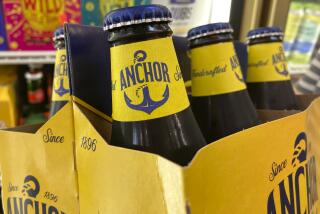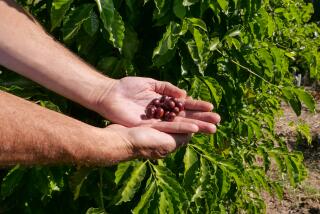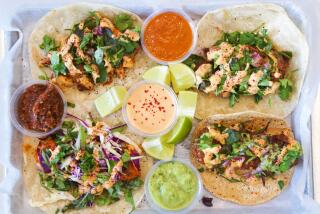Anchor Aweigh, Full Steam Ahead : 27 years ago, Fritz Maytag launched the ultimate California brewery--small, weird and the start of a national trend.
When the Loma Prieta earthquake rattled Candlestick Park during the 1989 World Series, legend has it one group of fans calmly remained in an orderly queue. They were waiting in line to buy Anchor Steam beer.
Now that’s brand loyalty.
“I used to say that we’re trying to make beer that most people won’t like,” says Fritz Maytag, the professorial owner of the Anchor Brewing Company. “Our beer wasn’t designed to please everybody, it was designed to please a few people a whole lot.”
Maytag, 58, a former Asian studies student who retains an affinity for Taoism, operates Anchor on the Eastern notion that small is beautiful, less is more--the uber-brewers at Anheuser-Busch make more beer in a morning than Anchor does in an entire year.
Yet what seemed like a harmless eccentricity 30 years ago--brewing small batches of flavorful, handcrafted all-natural beer--has become one of the fastest-growing industries in America. Consumers are demanding more flavor and variety in their beer, just as they are in coffee, wine, bread and other comestibles. Restaurants, bars and markets that once offered only Bud, Miller and a few imports now proudly serve potables with names like Killer Red Poppy Jasper Honey Raspberry Amber Ale. There are more than 800 craft breweries and brew pubs across the country, with about 150 of them in California. And San Francisco-based Anchor Steam, the oldest of the microbrewers, can rightly claim to be the epicenter of the movement.
“Anchor is a real icon,” says Tom Dalldorf, editor and publisher of the Celebrator Beer News. “It’s the signature California craft beer. You see Anchor taps in some of the best restaurants in the country.”
“It’s a flagship craft beer,” says George Johnson, head of the Craft Brewing Business Institute at Sonoma State University. “And they’ve influenced practically everybody in the industry.”
It’s no accident that Anchor and the microbrew revolution started in California. Besides having the population necessary to support an emerging boutique industry, California has what Maytag calls “cultural freedom”--the freedom to be different. In California, you could make an interesting beer that most people wouldn’t like and launch a fledgling industry.
“In California, we had a fantastic freedom to brew whatever we wanted,” says Maytag. “That had a big influence on us and the wine industry as well. It’s not that others couldn’t have done what we did. They didn’t do it because someone would have said, ‘That’s not the way it’s done.’ ”
Maytag first became involved with the Anchor Brewing Company in 1965, while a graduate student at Stanford University. A friend told him that the venerable brewery in San Francisco’s Portrero Hill neighborhood--which had been making draft beer since 1896--was about to go bankrupt. Maytag was already familiar with Anchor Steam as a consumer.
“I didn’t think the beer was so great, actually,” Maytag recalls. “But I loved the idea that there was a funny local beer.”
An heir to the Maytag appliance fortune, he sank $5,000 into Anchor to save it from going under, and more after he bought it outright in 1969. The brewing equipment Maytag inherited was crude. The brew house featured three steel storage tanks that were painted on the inside with varnish--perfect for making Old Brain Damage Ale, but not much else. Maytag replaced it with state-of-the-art materials and then steeped himself in the craft, visiting the master brewers of northern Europe.
Anchor began a bottling line in 1971 and moved into a larger building in 1979, a former Chase & Sanborn coffee plant on Mariposa Street. The flagship brand remains Anchor’s hoppy, malty “steam” beer, so named because 19th century Californians called the carbonation released by pressurized tanks “steam.”
But during the 1970s, Anchor began experimenting with other beer styles, a sense of adventure and fun that would become a hallmark of the craft brewers. Anchor Porter, a dark, creamy brew with subtle flavors of chocolate, toffee and coffee, debuted in 1974. Liberty Ale, an amber beer with a slightly fruity aroma, was rolled out the following year. Later came Old Foghorn Barley Wine, Anchor Wheat and the popular limited-edition Christmas Ale, featuring a different recipe and label each year.
Not not all of Anchor’s specialty beers were unqualified successes. One year, Anchor made a Spruce Beer that was the equivalent of being hit over the head with a Christmas tree and then forced to eat it.
“Yeah, there was too much spruce in it,” Maytag admits. “My own recommendation is that you drink it outdoors. Something about the fresh air makes the heavy spruce bearable.”
Following Anchor’s lead, other Californians began brewing their own specialty beers. In 1976, Jack McAuliffe founded the New Albion Brewing Company in Sonoma, the state’s first start-up microbrewery. Paul Camusi and Ken Grossman, two Southern Californians, opened the Chico-based Sierra Nevada Brewery in 1979, using a bottle filler bought cheap from Anchor. Three years later, the California Legislature changed a Prohibition-era law to allow beer to be brewed in a restaurant setting. Brew pubs quickly sprang up, fueling demand for more specialty beers.
Sierra Nevada is currently California’s and the nation’s largest true craft brewer, producing 156,000 barrels in 1994, compared to Anchor’s 102,000 barrels. (Samuel Adams and Pete’s Wicked Ale produce even more beer, 700,000 and 182,000 barrels respectively, but their beer is made by outside contract brewers. Anheuser-Busch, Miller and Coors combined to produce a staggering 153 million barrels that year.)
Even Maytag is a bit startled that the little guys are giving the big boys such a run for their money.
“When I first started, I said if I’m right, there will be dozens of little breweries someday,” Maytag says. “And everybody laughed. But even I’m surprised there are hundreds, not dozens, of little breweries.”
Craft brews are still a drop in the beer barrel, with about 2% of national beer sales. But their steady dribble of market share is unnerving to the major brewers, whose sales have remained flat or declined the past five years while microbrewers have grown 50% annually. The Big Boys are fighting back, either by buying into existing craft breweries (Anheuser-Busch now owns 25% of Redhook and Miller has a chunk of Shipyard, Celis and Leinenkugel breweries), by making all-malt craft-style beers of their own (such as Anheuser-Busch’s Elk Mountain and soon-to-be-released line of “American Originals”), or by making “stealth crafts,” cereal adjunct beers packaged to look like craft beers (such as Red Dog, made by Miller under the nom-de-beer of Plank Road Brewery). “What we’re seeing is a permanent realignment of the brewing industry,” says Jack Erickson, author of “California Brewin’ ” and other books on the microbrew industry.
Even though Anchor has more competition than ever, Maytag doesn’t worry about being left behind as other craft brewers pass him in volume. Nor is he considering selling out to a major brewery, which he could do with a phone call. “We’re at a nice size now,” he says. “I hope we grow a little bit more. But I’ve never wanted to get a lot bigger.”
Maytag’s stubborn independence is part of what makes Anchor Steam a distinctively California product. Like most of the pioneers, he didn’t come to California to duplicate what the Big Boys had already done. He wanted to reinvent the craft of brewing beer in much the same way people come to California to reinvent themselves for generations.
More to Read
Eat your way across L.A.
Get our weekly Tasting Notes newsletter for reviews, news and more.
You may occasionally receive promotional content from the Los Angeles Times.










